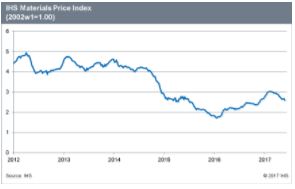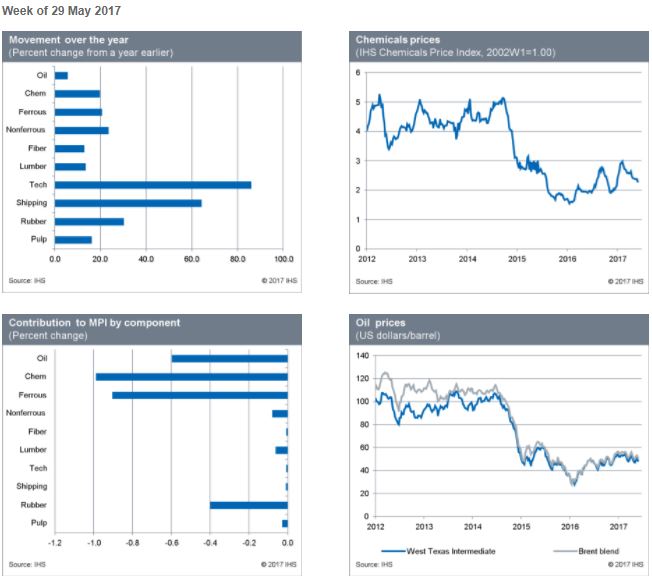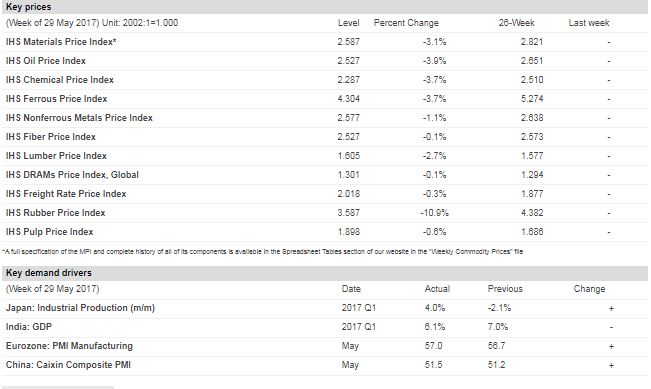 |
 |
Commodity markets experience hefty retreat as all 10 MPI sub-indexes slip
|
Last week the IHS Materials Price Index (MPI) slumped a whopping 3.1%, its largest weekly decline since mid-April. Our commodity price index is now back to levels last seen in November, with fully two-thirds of its big fourth-quarter rally erased. Last week's retreat was also broad-based, with all 10 sub-indexes falling. Driving the fall were oil, down 3.9%, and rubber, which crashed 10.9%.
Brent crude slipped back below $50/barrel last week as concerns about growing US supply dominated energy markets. It is thought that despite the OPEC supply agreement, increasing US shale production will continue to fuel excessive global supply. Last week ferrous markets were also down strongly, with the sub-component slipping 3.7% as iron ore prices continued to react to high inventory levels in China.
Oversupply appears to be re-emerging as the primary concern in commodity markets. Exuberant producers expanded output in the wake of the 2016 price surge but are now finding that demand is not keeping pace in some sectors. Indeed, the MPI's wide-ranging decline last week came despite a weakening US dollar and strong May manufacturing survey data across the Eurozone. What seems to have happened is that markets are focusing on China, where manufacturing appears softer in the latest data. We expect this dynamic to characterize the second half of the year—decelerating Chinese growth contrasting with improvement elsewhere. This suggests an environment in which prices receive support but not strong pressure.
|
| | IHS Materials Price Index |  |
|
| | 
| Market Insight
For an overview of the IHS Materials Price Index, view this video.
Get the Materials Price Index delivered to your in-box weekly.
Subscribe here.
|
|  |
| | |
|
| Industrial Materials: Prices |  |
| Key Prices & Demand Drivers |  |
Construction Costs Increase at Slower Pace in May, IHS Markit Says
|
The headline IHS Markit PEG Engineering and Construction Cost Index registered 54.0 in May, down from 57.0 in April. |
Both the materials/equipment and labor categories showed increases, though compared to April, the cost increases were not as broad. The materials/equipment price index came in at 55.2, almost five points lower than in April, which was one of the highest figures recorded in the survey’s history. “Steel prices peaked in April and are now beginning to weaken. Price drops will continue through at least the third quarter, more likely until the end of the year,” said John Anton, senior principal economist at IHS Markit. “Upside risk comes from the ‘Buy American’ proposal for pipelines, which is causing concern among energy buyers and plate consumers. If the proposal is enacted in its strongest form, there could be shortages in supply and allocation.”
| | Learn More |
|
| About IHS Pricing & Purchasing | | The IHS Pricing & Purchasing Service | The IHS Pricing & Purchasing Service enables supply chain cost savings by providing timely, accurate price forecasts and cost analysis. Armed with a better understanding of suppliers' cost structures and market dynamics, organizations can effectively negotiate prices, strategically time buys, and boost the bottom line.
With a database of more than 80,000 historic prices and thousands of price, wage and input cost forecasts, IHS offers more coverage than any other provider in the market. IHS has been providing forecasts of key commodity, labor, and input costs since 1970 -- helping define the purchasing advice industry. | | Learn More |
|
| Commodity Price Forecasts & Supply Chain Cost Benchmarking. Learn More | | |
|
|
|
